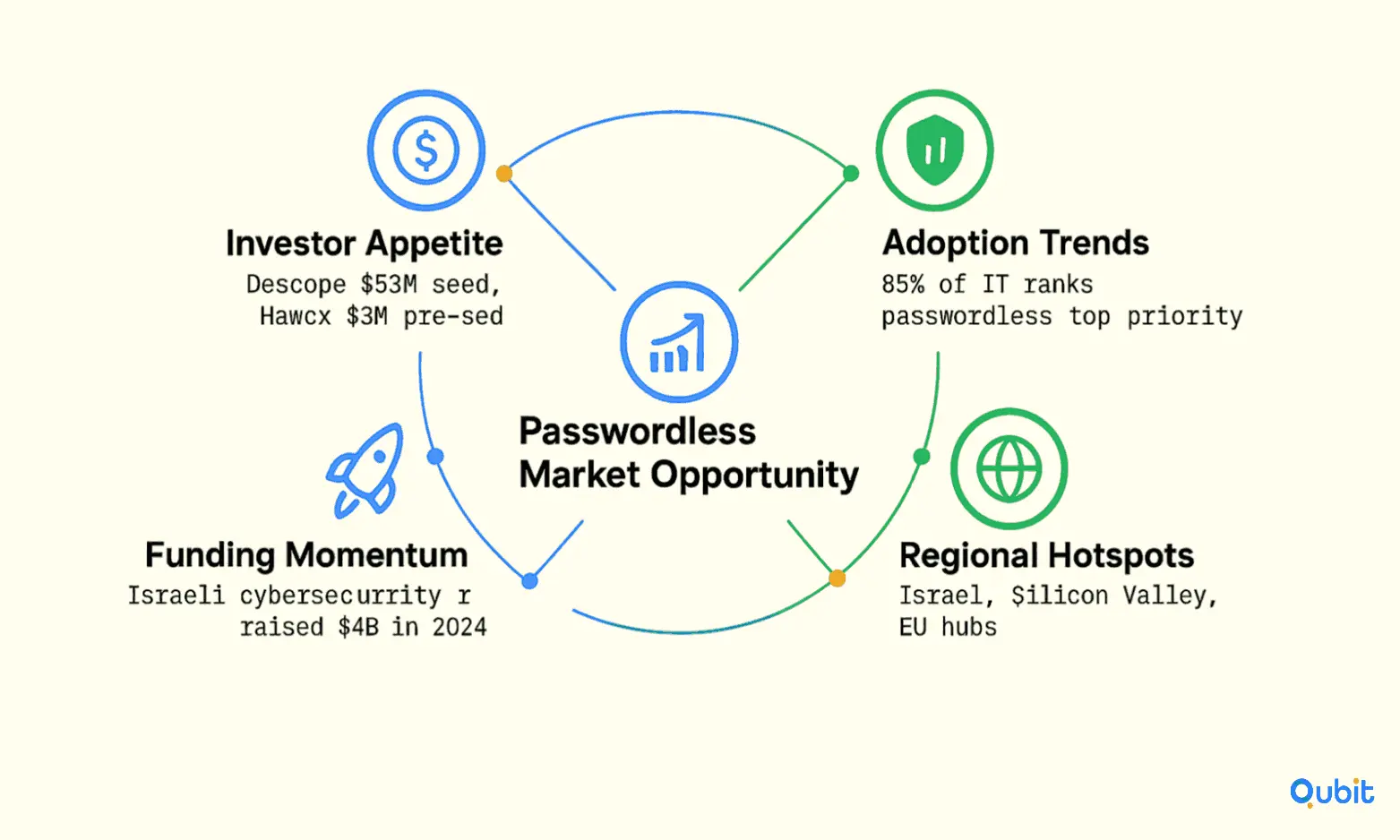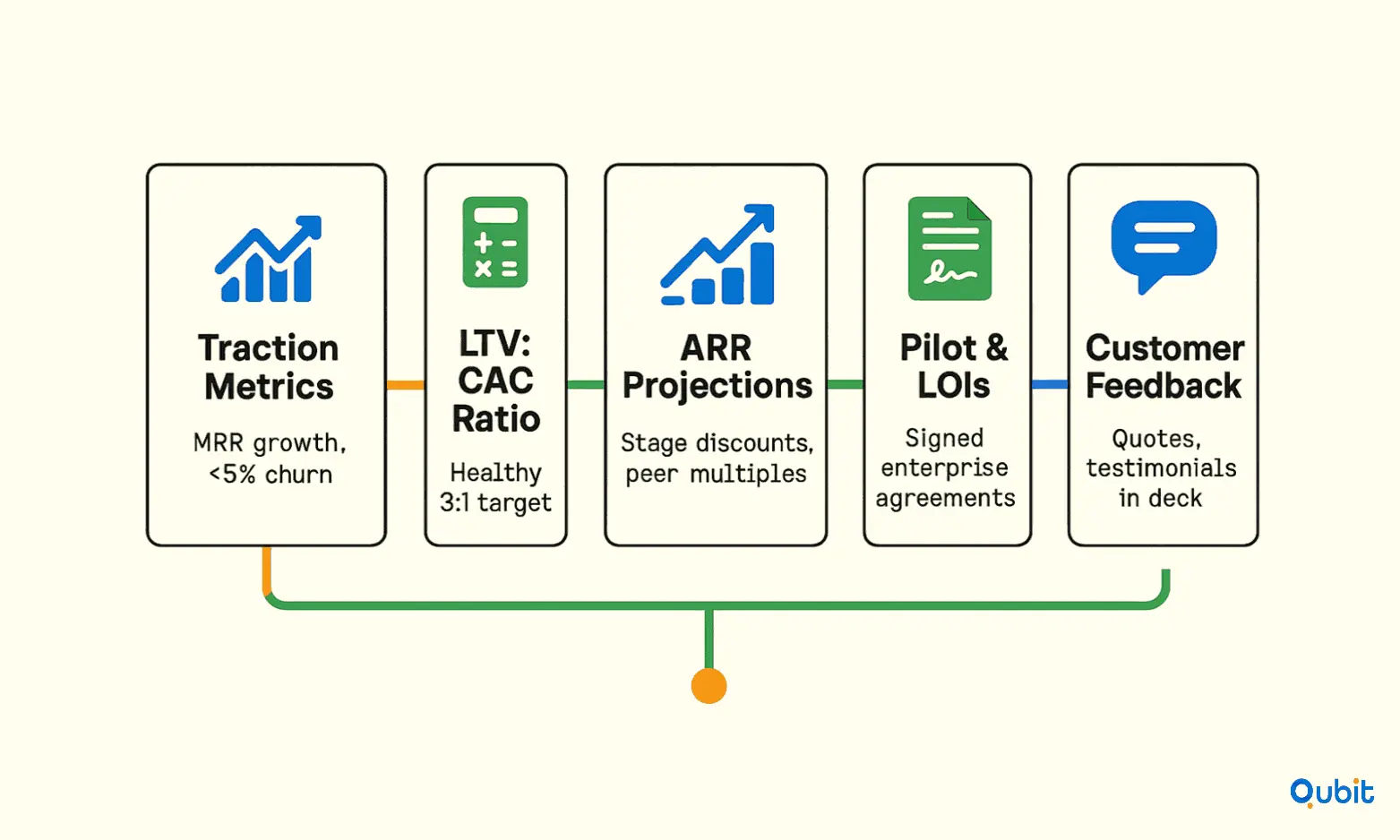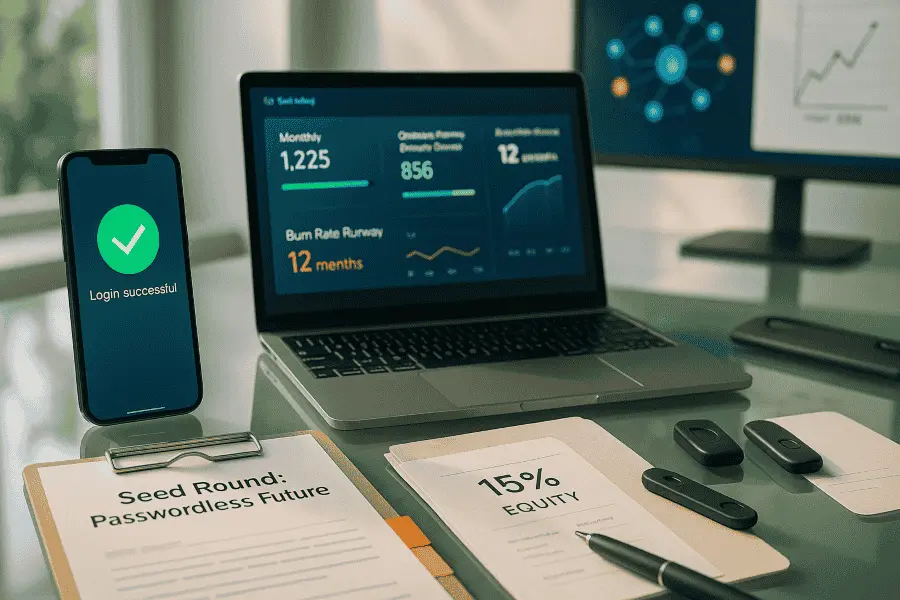Passwordless authentication has quickly become a cybersecurity priority, prompting a surge in interest from investors looking to back startups pioneering this space. Seed funding for passwordless authentication startups is booming, fueled by investor confidence, market growth projections, and strong adoption trends. Founders targeting seed funding must craft compelling pitches, optimize critical metrics, and clearly showcase their differentiation.
This guide delivers actionable strategies, data-driven insights, and proven frameworks to help you secure investment and accelerate your startup’s growth.
Let's get started!
Evaluating the Passwordless Authentication Market Opportunity
Analyzing funding trends, market potential, and adoption metrics, startups can position themselves effectively for seed rounds.
What Recent Funding Rounds Reveal About Investor Appetite
Investor interest in passwordless authentication startups is soaring. Notably, Descope raised $53 million in its seed round, a figure significantly higher than typical cybersecurity seed investments. Similarly, Hawcx secured $3 million in a pre-seed round, highlighting growing urgency for innovation. These substantial cybersecurity seed investments underscore the lucrative opportunity investors see in passwordless technology.
Additionally, startups featured among the top 100 cybersecurity companies regularly secure multimillion-dollar rounds, reflecting sustained momentum in the sector.
How Large is the Passwordless Authentication Market?

Global forecasts show robust growth in the passwordless market, validating investor interest. The market size for passwordless authentication is expected to surge significantly by 2028, driven by heightened enterprise adoption. In 2024 alone, Israeli cybersecurity firms raised $4 billion, signifying rapid sector growth.
Projections indicate the identity and access management sector—where passwordless solutions dominate—is growing at a compound annual growth rate (CAGR) exceeding 15%, emphasizing the scalability and potential returns for early-stage investors.
Passwordless Adoption Trends Underpinning Opportunity
Adoption trends highlight passwordless authentication’s growing necessity. Passwords cause over 86 % of data breaches globally, amplifying demand for secure alternatives. Notably, 85 % of IT and cybersecurity professionals rank passwordless solutions as a top priority, showcasing the enterprise demand driving seed funding passwordless authentication startups.
Regional Focus of Cybersecurity Seed Investments
Geographic hotspots like Israel, Silicon Valley, and European tech hubs are key centers for seed-stage capital deployment. According to the Seed 100 list, investors actively targeting cybersecurity startups focus significantly on these regions. Understanding these clusters can strategically inform investor outreach, leveraging regional funding distributions for better alignment.
To further enhance your funding approach, consider our comprehensive cybersecurity fundraising guide.
Optimizing Critical Metrics for Seed Funding Success
Seed funding metrics play a vital role in investor evaluation. Founders must effectively present traction metrics, financial benchmarks, and credible valuation projections.

Which Traction Metrics Are Most Influential?
Investors prioritize monthly recurring revenue (MRR) growth as a key performance indicator. Founders should aim for consistent month-over-month MRR increases, alongside low churn rates under 5%. Securing pilot agreements or letters of intent (LOIs) with at least two enterprise customers provides tangible traction, as do high user engagement metrics like daily active users (DAU) or authentication success rates.
What Constitutes a Healthy LTV:CAC Ratio?
A healthy LTV CAC ratio is at least 3:1, aligning with investor benchmarks for sustainability. However, early-stage startups may begin at approximately 1.3:1 while refining their customer acquisition processes. Additionally, a CAC payback period under 12 months signals efficient capital use, reassuring investors.
Projecting ARR and Seed Valuation
Realistic ARR projections significantly strengthen seed-stage valuations. Startups typically benchmark valuation multiples at around 10x ARR for SaaS models, adjusted by a stage discount, commonly around 65%. For instance, an $800K ARR projection at a 10x multiple with a stage discount suggests a credible $5.2M pre-money valuation.
To better understand typical revenue benchmarks, founders may consult our iam arr benchmarks article.
How Should Founders Project ARR and Valuation at Seed Stage?
- ARR Projections: Base on current MRR and pipeline conversion rates.
- Valuation Methods: Apply stage-based discounts (e.g., 65% of full ARR multiple) for realistic seed valuations.
- Peer Multiples: Use industry benchmarks (e.g., 10x ARR for SaaS) to support your case.
- Documentation: Clearly outline assumptions and reference comparable cybersecurity seed rounds.
When and How to Present Pilots, LOIs, and Customer Feedback?
- Pilot Agreements: Showcase signed LOIs or pilots from CISOs to validate demand.
- Customer Feedback: Include anonymized quotes emphasizing security and ease of use.
- Paid Deployments: Highlight willingness to pay to reduce perceived risk.
- Pitch Deck Addendum: Package testimonials and proof points for investor review.
Crafting an Impactful Seed Pitch Deck
A robust pitch deck is critical in securing seed funding, emphasizing the right blend of market potential, traction validation, and team expertise.
What Core Sections Must Every Seed Deck Include?
- Executive Summary: Clearly state the problem and your solution.
- Market Size: Visualize opportunity with credible data.
- Product Demo: Use visuals and highlight key features.
- Business Model: Explain revenue streams and go-to-market strategy.
- Financial Projections: Show ARR, MRR, and growth forecasts.
- Ask Slide: Detail funding needs, milestones, and use of proceeds.
How to Showcase Team Credibility and Domain Expertise?
- Founder Bios: Highlight relevant cybersecurity experience and successful exits.
- Advisors/Angels: Feature board members with notable expertise.
- Testimonials: Embed endorsements from security experts or pilot customers.
Which Traction Slides Best Convey Early Validation?
- Key Metrics: Emphasize MRR growth, pilot agreements, and signed LOIs.
- Charts: Visualize user adoption and authentication success rates.
- Case Studies: Include customer stories or quotes to humanize your data.
How to Frame the Market Opportunity and Go-to-Market Plan?
- Market Data: Present size and CAGR visually, citing industry reports.
- GTM Plan: Outline target segments, channels, and partnerships.
- Validation Points: Highlight corporate VC interest or strategic partnerships.
Highlighting Your Competitive Edge
What Core Features Distinguish Your Solution from Competitors?
- Standout Features: Multi-factor fallback, cross-platform support, SDK integration ease.
- Performance Benchmarks: Low authentication latency, minimal failure rates, high uptime.
- Proprietary Tech: Patented algorithms, cryptographic methods, unique UX flows.
How to Proactively Mitigate Implementation Challenges?
- Device Compatibility: Address passkey conflicts on legacy hardware.
- User Training: Implement in-app tutorials and dedicated support channels.
- Fallback Mechanisms: Ensure access in offline or low-connectivity environments.
Which Security and Compliance Standards Increase Investor Confidence?
- Certifications: FIDO2, WebAuthn, SOC 2 Type II.
- Partnerships: Collaborate with standards bodies or security audit firms.
- Data Protection: Demonstrate encryption-at-rest and in-transit for sensitive data.
What Role Can Corporate VC Play in Your Seed Round?
Corporate venture capital (CVC) firms, such as Merlin Ventures, are increasingly active in the IAM and cloud security space. For passwordless authentication startups, CVCs offer more than just capital, they provide strategic value through industry expertise, access to enterprise customers, and potential distribution channels. To maximize your chances, align your pitch with the corporate investor’s strategic objectives and demonstrate how your technology can complement or enhance their core offerings. Negotiating joint pilot programs or co-development initiatives can further strengthen the relationship, providing both validation and early market traction.
Understanding how corporate VCs evaluate IAM investments can further inform your approach—more information can be found in our corporate vc iam investments overview.
How to Leverage Crowdfunding for Identity Protection Innovations?
Crowdfunding is a viable alternative funding channel for early-stage identity protection startups. A successful campaign should be built on transparency, with clear demonstrations of your product and a public roadmap. Setting realistic funding goals and offering reward tiers, such as early access or premium features—can incentivize backers. Engaging with online communities and identity protection advocates is crucial for building early momentum and credibility, turning backers into brand ambassadors who can help amplify your message.
For startups interested in alternative community-based fundraising methods, consider reviewing our guide on crowdfunding identity protection.
Which Accelerator Programs or Competitions Boost Credibility?
Accelerator programs like YL Ventures and Techstars Security offer more than funding, they provide mentorship, industry connections, and a stamp of credibility that can open doors with future investors. Participating in high-profile competitions, such as those at RSA Conference or Money20/20, can also increase your visibility and attract investor attention. Showcasing completion badges or accolades from these programs in your investor materials serves as powerful third-party validation, demonstrating that your startup has been vetted by industry experts.
What Strategic Alliances Can Unlock Co-Development Funding?
Strategic alliances with IAM platforms or OEMs can unlock co-development funding and accelerate your go-to-market strategy. By collaborating on integration projects or offering revenue-sharing models, you can align incentives and share resources with established players. Securing letters of support or pilot commitments from these partners not only strengthens your funding pitch but also signals market validation to potential investors.
Mapping Your Post-Seed Roadmap
Which Milestones Signal Readiness for Series A?
To position your startup for a successful Series A, you should aim to double your monthly recurring revenue (MRR) within six months post-seed. Securing at least three paid enterprise pilots or deployments demonstrates real-world traction, while outlining a clear and credible path to $1 million in annual recurring revenue (ARR) reassures investors of your growth potential.
How to Align Product Roadmaps and Hiring with Investor Expectations?
Your product roadmap should be closely tied to customer feedback and pain points, ensuring that each feature release addresses real market needs. As you scale, prioritize hiring in sales, customer success, and engineering, and develop an organizational chart that projects critical hires over the next 12 to 18 months. This approach demonstrates operational discipline and readiness for rapid growth.
What Financial and Operational Benchmarks Matter Next?
Maintaining at least 12 months of runway after your seed round is essential for financial stability. Closely monitor unit economics, such as your LTV:CAC ratio and the number of months it takes to recover CAC, to ensure your growth is sustainable. Operational KPIs, including support ticket resolution times and uptime SLAs, are also important indicators of customer satisfaction and product reliability.
How to Prepare for Due Diligence and Investor Communications?
Thorough preparation for due diligence is critical as you approach Series A. Compile a comprehensive data room containing financial models, your cap table, and customer contracts. Establish a regular cadence for investor updates, providing concise progress reports and key metrics to keep stakeholders engaged. Finally, ensure all legal documents and IP assignments are up to date to minimize potential red flags and streamline the fundraising process.
Conclusion
Seed funding passwordless authentication startups is highly competitive yet immensely rewarding for founders who strategically approach market positioning, traction metrics, differentiation, and alternative funding sources. Get tailored guidance from Qubit Capital’s Fundraising Advisory Service to accelerate your seed round.
Key Takeaways
- Passwordless authentication startups attract strong investor interest, with seed rounds often reaching multimillion-dollar valuations.
- Consistent MRR growth, robust LTV:CAC ratios, and clear pilot traction strongly influence seed-stage funding decisions.
- Competitive differentiation, compliance readiness, and strategic partnerships are essential components of a compelling investor pitch.
- Alternative funding channels, including corporate VC and crowdfunding, complement traditional seed funding efforts.
- Demonstrable progress post-seed, including strategic hiring, financial discipline, and customer traction—is crucial to securing Series A funding.
Frequently asked Questions
Why are passwordless authentication startups seeing big seed valuations?
Investors love the security edge and smooth UX, so seed rounds often hit multimillion-dollar valuations as founders show big market potential and clear vision, despite early-stage risks.






